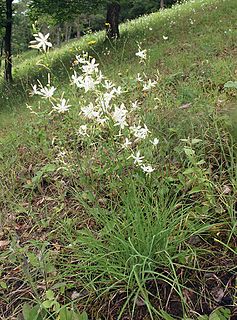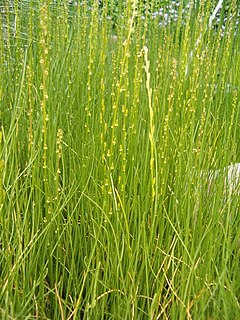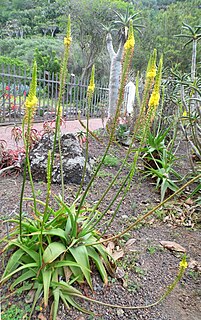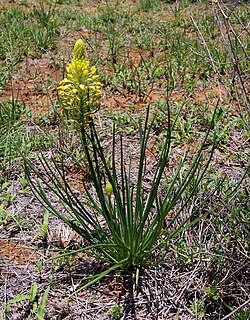
Anthericum is a genus of about 65 species, rhizomatous perennial plants in the family Asparagaceae, subfamily Agavoideae. It was formerly placed in its own family, Anthericeae. The species have rhizomatous or tuberous roots, long narrow leaves and branched stems carrying starry white flowers. The members of this genus occur mainly in the tropics and southern Africa and Madagascar, but are also represented in Europe.

Triglochin is a plant genus in the family Juncaginaceae described by Carl Linnaeus in 1753. It is very nearly cosmopolitan in distribution, with species on every continent except Antarctica. North America has four accepted species, two of which can also be found in Europe: Triglochin palustris and Triglochin maritima. Australia has many more.

Bulbine bulbosa, commonly known as bulbine lily, native leek, golden lily, or native onion, is a species of flowering plant in the family Asphodelaceae and is endemic to Australia. It is a perennial herb with thick roots, channelled leaves, and yellow flowers with hairy stamen filaments.

The red-breasted chat is a species of bird in the family Cardinalidae, the cardinals or cardinal grosbeaks. It is endemic to Mexico.
Bulbine caput-medusae is a species of plant in the Asphodelaceae family. It is endemic to Namibia. Its natural habitats are dry savanna and hot deserts.
Bulbine namaensis is a species of plant in the genus Bulbine. It is native to Namibia and to the Cape Provinces in South Africa. Its natural habitat is dry savanna.

Helicia is a genus of 110 species of trees and shrubs, constituting part of the plant family Proteaceae. They grow naturally in rainforests throughout tropical South and Southeast Asia, including India, Sri Lanka, Indochina, Peninsular Malaysia to New Guinea and as far south as New South Wales.

Volutomitra is a genus of sea snails, marine gastropod molluscs in the family Volutomitridae, the mitres, with global distribution.

Bulbine semibarbata, commonly known as leek lily, native leek or wild onion, is a species of annual herb native to Australia.
Typhis francescae is a species of sea snail, a marine gastropod mollusk in the family Muricidae, the murex snails or rock snails.

Typhis is a genus of sea snails, marine gastropod mollusks in the family Muricidae, the murex snails or rock snails.

The World's 25 Most Endangered Primates is a list of highly endangered primate species selected and published by the International Union for Conservation of Nature (IUCN) Species Survival Commission (SSC) Primate Specialist Group (PSG), the International Primatological Society (IPS), Global Wildlife Conservation (GWC), and Bristol Zoological Society (BZS). The IUCN/SSC PSG worked with Conservation International (CI) to start the list in 2000, but in 2002, during the 19th Congress of the International Primatological Society, primatologists reviewed and debated the list, resulting in the 2002–2004 revision and the endorsement of the IPS. The publication was a joint project between the three conservation organizations until the 2012–2014 list when BZS was added as a publisher. The 2018–2020 list was the first time Conservation International was not among the publishers, replaced instead by GWC. The list has been revised every two years following the biannual Congress of the IPS. Starting with the 2004–2006 report, the title changed to "Primates in Peril: The World's 25 Most Endangered Primates". That same year, the list began to provide information about each species, including their conservation status and the threats they face in the wild. The species text is written in collaboration with experts from the field, with 60 people contributing to the 2006–2008 report and 85 people contributing to the 2008–2010 report. The 2004–2006 and 2006–2008 reports were published in the IUCN/SSC PSG journal Primate Conservation,, since then they have been published as independent publications.

Bulbine cepacea is a flowering plant in the genus Bulbine, endemic to the Western Cape province, South Africa.
Bulbine bruynsii is a species of plant in the genus Bulbine. It is endemic to South Africa.
Bulbine glauca is also known as rock lily. The genus Bulbine is made up of about fifty species. Most are native to Southern or Eastern Africa, but five species, including B. glauca, are native to Australia.
Rugotyphis is an extinct genus of sea snails, marine gastropod mollusks, in the family Muricidae, the murex snails or rock snails.

Bulbine alooides ("Rooistorm") is a species of geophytic plant in the genus Bulbine. It is widespread in rocky areas in the southern Cape of South Africa.

Bulbine abyssinica is a species of plant in the genus Bulbine, from eastern and southern Africa.












